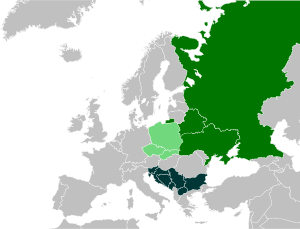Serbs
|
1st row: Jovan Vladimir • Stefan Nemanja • Saint Sava • Dušan the Mighty • Tsar Lazar • Mehmed-paša Sokolović 2nd row: Zaharije Orfelin • Dositej Obradović • Karađorđe • Miloš Obrenović • Vuk Karadžić • Njegoš | |
| Total population | |
|---|---|
| 10.5-12 million[1][2] | |
| Regions with significant populations | |
|
| |
| Former Yugoslavia | c. 1.9 million |
(mainly in | 1,339,019 (2013)[3][4] |
| 186,633 (2011)[5] | |
| 178,110 (2011)[6] | |
| 35,939 (2002)[7] | |
| 38,964 (2002)[8] | |
| Rest of Europe | c. 1.7 million |
| 300-400,000+ | |
| c. 300,000 (est.)[9] | |
| c. 120,000 (est.) | |
| c. 120,000 (est.)[10] | |
| c. 70,000 (2001 est.)[11] | |
| 33,009 (2015)[12][13] | |
| 18,076 (2011)[14] | |
| North America | c. 450,000 |
| 199,080 (2012)[15] | |
| 80,320 (2011)[16] | |
| Rest of the world | |
| 69,544 (2011)[17] | |
| over 20,000[18] | |
| Languages | |
| Serbian | |
| Religion | |
|
Predominantly † Eastern Orthodox Christianity (Serbian Orthodox Church) | |
| Related ethnic groups | |
| Other South Slavic peoples (especially Montenegrins) | |
|
a The 2011 census in Kosovo registered a total of 25,532 Serbs (excl. North Kosovo),[19] out of an estimated total of around 100,000 Serbs which by large boycotted Kosovo census.[20] b Some 265,895 persons declared Serbian language as their mother tongue.[21] c The real number of people of Serbian descent in North America and Australia is higher, as the majority of people who declare as Yugoslavians/Yugoslavs (310,682 in the U.S.,[15] 48,320 in Canada[16] and 26,883 people in Australia[22]) will be of Serbian origin.[23] | |
The Serbs (Serbian: Срби / Srbi, pronounced [sr̩̂bi]) are a South Slavic nation and ethnic group native to the Balkans. The majority of Serbs inhabit Serbia (including the disputed territory of Kosovo), as well as Bosnia and Herzegovina (mostly Republika Srpska) and Montenegro, and form significant minorities in Croatia, the Republic of Macedonia and Slovenia. Likewise, Serbs are an officially recognized minority in Romania, Hungary, Albania, the Czech Republic and Slovakia. There is a large Serbian diaspora in Western Europe, particularly in Germany, Austria, Switzerland, France, and Sweden. Outside Europe, there are significant Serb communities in the United States, Canada and Australia.
The Serbs share cultural traits with the rest of Southeast Europe, and are predominantly Orthodox Christians by religion. The Serbian language is an official language in Serbia (also in the disputed Kosovo) and Bosnia and Herzegovina, and is spoken by a majority in Montenegro. The Serbian language has a historically active digraphia, using both Cyrillic and Latin alphabets.
Anthropology
The modern identity of Serbs is rooted in Eastern Orthodoxy and Serb traditions. The Serbs speak the Serbian language, one of the South Slavic languages. When the Principality of Serbia gained independence from the Ottoman Empire, Orthodoxy became crucial in defining the national identity, instead of language which was shared by other South Slavs (Croats and Bosniaks).[24] The origin of their ethnonym is unclear (see Names of the Serbs and Serbia). Genetic studies on Serbs show that they share genetic traits with the rest of the Balkan peoples, especially those of former Yugoslavia. The Serbs were historically defined as part of the "Dinaric race". Serbs are among the tallest people in world, after Montenegrins and Dutch with an average male height of 1.82 metres (6 ft 0 in).[25]
History
Middle Ages
Slavs settled in the Balkans in the 6th and 7th centuries. They mixed with the local population (Illyrians, Thracians, Dacians, Romans, Celts).[26] First, they came under Bulgarian and then Byzantine rule after 900.[27] Later, Serbs created numerous small states located in Bosnia and Herzegovina, Montenegro and Serbia. One of the most powerful Serbian states during this period was Raška, which separated from the Serbian state of Duklja in the 11th century.[26] Ruled by Prince Stefan Nemanja from 1169 to 1196, Duklja conquered the neighbouring Serb territories of Kosovo, Duklja and Zachlumia. Subsequently, he created the Nemanjić dynasty, which ruled over Serbia until the 14th century. Nemanja's older son, Stefan Nemanjić, became Serbia's first recognized king, while his younger son, Rastko, founded the Serbian Orthodox Church in the year 1219, and became known as Saint Sava after his death.[27]

Over the next 140 years, Serbia expanded its borders. Its cultural model remained Byzantine, despite political ambitions directed against the empire. The medieval power and influence of Serbia culminated in the reign of Stefan Dušan, who ruled the state from 1331 until his death in 1355. Ruling as Emperor from 1346, his territory included Macedonia, northern Greece, Montenegro, and almost all of Albania.[28] When Dušan died, his son Stephen Uroš V became Emperor.[29] With Turkish invaders beginning their conquest of the Balkans in the 1350s, a major conflict ensued between them and the Serbs, the first major battle was the Battle of Maritsa (1371),[30] in which the Serbs were defeated.[31] With the death of two important Serb leaders in the battle, and with the death of Stephen Uroš that same year, the Serbian Empire broke up into several small Serbian domains.[30] These states were ruled by feudal lords, with Zeta controlled by the Balšić family, Raška, Kosovo and northern Macedonia held by the Branković family and Lazar Hrebeljanović holding today's Central Serbia and a portion of Kosovo.[32] Hrebeljanović was subsequently accepted as the titular leader of the Serbs because he was married to a member of the Nemanjić dynasty.[30] In 1389, the Serbs faced the Ottomans at the Battle of Kosovo on the plain of Kosovo Polje, near the town of Pristina.[31] Both Lazar and Sultan Murad I were killed in the fighting.[33] The battle most likely ended in a stalemate, and Serbia did not fall to the Turks until 1459.[33]
Early modern period
With the Ottoman occupation of Serbia, countless Serbs fought against the Ottomans and organized uprisings in Serb territories that were under Ottoman rule. As a result, Serbs suffered severe consequences. In the 17th century, as many as 60,000 Serbs fled Kosovo during the Great Turkish War and settled in the Habsburg Monarchy. Serbia remained under Ottoman control until the early 19th century, with the eruption of the Serbian Revolution in 1804.
Modern period
The uprising ended in the early 1830s, with Serbia's autonomy and borders being recognized, and with Miloš Obrenović being recognized as its ruler. The last Ottoman troops withdrew from Serbia in 1867, although Serbia's independence was not recognized internationally until the Congress of Berlin in 1878.[34]
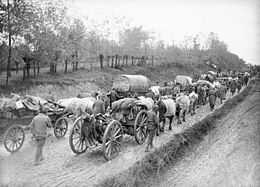
Serbia fought in the Balkan Wars of 1912–13, which forced the Ottomans out of the Balkans and doubled the territory and population of the Kingdom of Serbia. In 1914, a young Bosnian Serb student named Gavrilo Princip assassinated Archduke Franz Ferdinand of Austria, which directly contributed to the outbreak of World War I.[35] In the fighting that ensued, Serbia was invaded by Austria-Hungary. Despite being outnumbered, the Serbs subsequently defeated the Austro-Hungarians at the Battle of Cer, which marked the first Allied victory over the Central Powers in the war.[36] Further victories at the battles of Kolubara and the Drina meant that Serbia remained unconquered as the war entered its second year. However, an invasion by the forces of Germany, Austria-Hungary and Bulgaria overwhelmed the Serbs in the winter of 1915, and a subsequent withdrawal by the Serbian Army through Albania took the lives of more than 240,000 Serbs. Serb forces spent the remaining years of the war fighting on the Salonika Front in Greece, before liberating Serbia from Austro-Hungarian occupation in November 1918.[37]

Serbs subsequently formed the Kingdom of Serbs, Croats and Slovenes with other South Slavic peoples. The country was later renamed the Kingdom of Yugoslavia, and was led from 1921 to 1934 by King Alexander I of the Serbian Karađorđević dynasty.[38] During World War II, Yugoslavia was invaded by the Axis powers in April 1941. The country was subsequently divided into many pieces, with Serbia being directly occupied by the Germans.[39] Serbs in the Independent State of Croatia (NDH) experienced persecution at the hands of the Croatian ultra-nationalist, fascist Ustaše, who attempted to exterminate the Serb population in death camps. More than half a million Serbs were killed in the territory of Yugoslavia during World War II.[40] Serbs in occupied Yugoslavia subsequently formed a resistance movement known as the Yugoslav Army in the Homeland, or the Chetniks. The Chetniks had the official support of the Allies until 1943, when Allied support shifted to the Communist Yugoslav Partisans, a multi-ethnic force, formed in 1941, which also had a large majority of Serbs in its ranks in the first two years of war, later, after the fall of Italy, September 1943. other ethic groups joined Partisans in larger numbers.[39] At the end of the war, the Partisans, led by the Croat Josip Broz Tito, emerged victorious. Yugoslavia subsequently became a Communist state. Tito died in 1980, and his death saw Yugoslavia plunge into economic turmoil.[41] Yugoslavia disintegrated in the early 1990s, and a series of wars resulted in the creation of five new states. The heaviest fighting occurred in Croatia and Bosnia and Herzegovina, whose Serb populations rebelled and sought unification with Serbia, which was then still part of the Federal Republic of Yugoslavia. The war in Croatia ended in August 1995, with a Croatian military offensive known as Operation Storm crushing the Croatian Serb rebellion and causing as many as 200,000 Serbs to flee the country. The Bosnian War ended that same year, with the Dayton Agreement dividing the country along ethnic lines. In 1998–99, a conflict in Kosovo between the Yugoslav Army and Albanians seeking independence erupted into full-out war, resulting in a 78-day-long NATO bombing campaign which effectively drove Yugoslav security forces from Kosovo.[42] Subsequently, more than 200,000 Serbs and other non-Albanians fled the province.[43] On 5 October 2000, Yugoslav President Slobodan Milosević was overthrown in a bloodless revolt after he refused to admit defeat in the 2000 Yugoslav general election.[44]
Demographics
There are nearly 8 million Serbs living in their autochthonous region of Western Balkans. In Serbia (the nation state of Serbs), around 6 million people identify themselves as Serbs, and constitute about 83% of the population. Another 100,000+ still inhabit the disputed area of Kosovo, 1.4 million live in Bosnia and Herzegovina (predominantly in Republika Srpska), where they are one of the three constituent ethnic groups. The Serb minorities in Croatia and Montenegro number some 186,000 and 178,000 people, respectively. Smaller Serb minorities exist in Macedonia (36,000) Romania (18,000), and Hungary (around 7,000 Serbs).
Diaspora
There are over 2 million Serbs in diaspora throughout the world, although some sources put that figure as high as 4 million.[45] Existence of a numerous Serbian diaspora are mainly consequences of either economic or political (coercion or expulsions) reasons. There were several waves of Serbian emigration:

- first wave of Serb emigration took place since the end of 19th century and lasted until the World War II and was caused by economic reasons; particularly large numbers of Serbs (mainly from peripheral ethnic areas such as Herzegovina, Montenegro, Dalmatia, and Lika) emigrated to the United States.
- second wave took place after the end of the World War II. At this time, members of royalist Chetniks and other political opponents of communist regime fled the country mainly going overseas (United States and Australia) and, to a lesser degree, United Kingdom.
- third, and by far the largest wave, was economic emigration started in the 1960s when several Western European countries signed billateral agreements with then-Yugoslavia allowing the recruitment of workers from Yugoslavia to work in the industrial sector of those countries, and lasted until the end of the 1980s. Main destinations for Serbian emigrants were West Germany, Austria, and Switzerland, and to a lesser extent France and Sweden. That generation of Serbian diaspora is collectively known as gastarbajteri (after German word "Gastarbeiter" meaning guest-worker, since most of the emigrants headed for German-speaking countries).
- most recent emigration took place during the 1990s, and was caused by both political and economic reasons. Political reasons were the dominant cause for Serbs from Croatia and Bosnia and Herzegovina since there was war raging in the first half of the 1990s. On the other side, for Serbs from Serbia, the main reasons for emigrating was economic collapse which Serbia experienced during that decade caused by the UN economic sanctions imposed on the country. It is estimated that 300,000 people left Serbia during that period, 20% of which had a higher education.[46][47]
Culture
Literature, icon painting, music and dance and Mediaeval architecture are the artistic forms for which Serbia is best known. Traditional Serbian visual art (specifically frescoes, and to some extent icons), as well as ecclesiastical architecture is highly reflective of Byzantine traditions, with some Mediterranean and Western influence.
In the modern times (since the 19th century) Serbs also have a noteworthy classical music and works of philosophy.[48]
Art and science

During the 12th and 13th centuries, many icons, wall paintings and manuscript miniatures came into existence, as many Serbian Orthodox monasteries and churches such as those at Studenica, Sopoćani, Gračanica and Visoki Dečani were built.[49] The architecture of some of these monasteries is world famous.[27] Since the mid-1800s, Serbia has produced many famous painters who are representative of general European artistic trends.[49] One of the most prominent of these was Paja Jovanović, who painted massive canvases on historical themes such as the Great Serb Migrations. Painter Uroš Predić was also very prominent in the field of Serbian art, painting the Kosovo Maiden, which was completed in 1919.[50] While Jovanović and Predić were both realist painters, artist Đura Jakšić was an accomplished Romanticist. Painter Vladimir Veličković was famous for his surrealism.[51]
Most literature written by early Serbs was about religious themes. Various Gospels, Psalters, menologies, hagiographies, and essays and sermons of the founders of the Serbian Orthodox Church were written. At the end of the 12th century, two of the most important pieces of Serbian medieval literature were created– the Miroslav Gospels and the Vukan Gospels, which combined handwritten Biblical texts with painted initials and small pictures.[27] Notable Baroque-influenced authors were Andrija Zmajević, Gavril Stefanović Venclović, Jovan Rajić, Zaharije Orfelin and others. Dositej Obradović was the most prominent figure of the Age of Enlightenment, while the most notable Classicist writer was Jovan Sterija Popović, although his works also contained elements of Romanticism. Modern Serbian literature began with Vuk Karadžić's collections of folk songs in the 19th century, and the writings of Petar II Petrović-Njegoš, the 19th century Prince-Bishop of Montenegro. The first prominenet representative of Serbian literature in the 20th century was Jovan Skerlić, who wrote in pre-World War I Belgrade and helped introduce Serbian writers to literary modernism. The most important Serbian writer in the inter-war period was Miloš Crnjanski.[52] The first Serb authors who appeared after World War II were Mihailo Lalić and Dobrica Ćosić.[53] Other famous post-war authors were Ivo Andrić and Meša Selimović, both of whom identified as Serbs.[52] Andrić went on to win the Nobel Prize in Literature in 1961.[53] Danilo Kiš, another popular Serbian writer, was known for writing A Tomb for Boris Davidovich, as well as several acclaimed novels.[52] Amongst contemporary Serbian writers, Milorad Pavić stands out as being the most critically acclaimed, with his novels Dictionary of the Khazars, "Landscape Painted with Tea" and "The Inner Side of the Wind" bringing him international recognition. Highly revered in Europe and in South America, Pavić is considered one of the most intriguing writers from the beginning of the 21st century.[54]
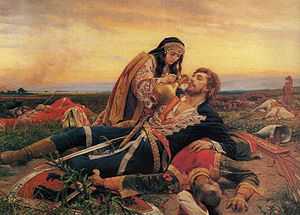
Traditional Serbian music includes various kinds of bagpipes, flutes, horns, trumpets, lutes, psalteries, drums and cymbals. The kolo is the traditional collective folk dance, which has a number of varieties throughout the regions. Composer and musicologist Stevan Stojanović Mokranjac is considered one of the most important founders of modern Serbian music.[55][56]
Serbia has produced many talented filmmakers, the most famous of whom are Dušan Makavejev,[57] Živojin Pavlović, Goran Paskaljević and Emir Kusturica.[58] Kusturica became world-renowned after winning the Palme d'Or twice at the Cannes Film Festival. He has won numerous other prizes, and is a UNICEF National Ambassador for Serbia.[58] Several Serbs have featured prominently in Hollywood. The most notable of these are Academy-award winners Karl Malden,[59] Steve Tesich, Peter Bogdanovich and Milla Jovovich.[60]
Many Serbs have contributed to the field of science and technology. Serbian American scientist, inventor, physicist, mechanical engineer and electrical engineer Nikola Tesla is regarded as one of the most important inventors in history. He is renowned for his contributions to the discipline of electricity and magnetism in the late 19th and early 20th century. Physicist and physical chemist Mihajlo Pupin is best known for his landmark theory of modern electrical filters as well as for his numerous patents, while Milutin Milanković is best known for his theory of long-term climate change caused by changes in the position of the Earth in comparison to the Sun, now known as Milankovitch cycles.[61] Mihailo Petrović is known for having contributed significantly to differential equations and phenomenology, as well as inventing one of the first prototypes of an analog computer.
Language

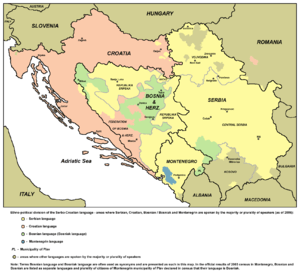
Serbs speak the Serbian language, a member of the South Slavic group of languages, specifically in the Southwestern Slavic group, with the Southeastern group containing Bulgarian and Macedonian. Standard Serbian is considered a variety of Serbo-Croatian, as mutually intelligible with the Croatian and Bosnian languages (see Differences in standard Serbian, Croatian and Bosnian) which are all based on the Shtokavian dialect.[62]
Serbian is an official language in Serbia and Bosnia-Herzegovina and is a recognized minority language in Montenegro (although spoken by a plurality of population), Croatia, Macedonia, Romania, Hungary, Czech Republic and Slovakia. Older forms of literary Serbian are Church Slavonic of the Serbian recension, which is still used for ecclesiastical purposes, and Slavonic-Serbian - a mixture of Serbian, Church Slavonic and Russian used from mid-18th century to the first decades of the 19th century.
Serbian has active digraphia, with speakers using both Cyrillic and Latin alphabets.[63] Serbian Cyrillic was devised in 1814 by Serbian linguist Vuk Karadžić, who created the alphabet on phonemic principles.[64]
Loanwords in the Serbian language besides common internationalisms are mostly from Turkish, German and Italian, while words of Hungarian origin are present mostly in the north and Greek words are predominant in the liturgy. Two Serbian words that are used in many of the world's languages are "vampire" and "paprika". The English term vampire was derived (possibly via French vampyre) from the German Vampir, which was in turn derived in the early 18th century from the Serbian word вампир/vampir, when Arnold Paole, a purported vampire in Serbia was described as wreaking havoc in Serbian villages during the time that Serbia was incorporated into the Austrian Empire.
Names
There are several different layers of Serbian names. Serbian first names largely originate from Slavic roots: e.g., Slobodan, Miroslav, Vladimir, Vukašin, Zoran, Ljubomir, Vesna, Leposava, Radmila, Gordana, Dragan, Milan, Goran, Radomir, Miomir, Branimir, Budimir, Slavimir. Some may be non-Slavic but chosen to reflect Christian faith and often originate from Hebrew for Biblical reasons. Christian names include: Nikola, Ivan, Jovan, Marija, Ana, Mihailo. Along similar lines of non-Slavic names among Christians, the origins for many such names are Greek: Aleksandar, Filip, Jelena, Katarina, Đorđe, Stefan, Vasilije, Todor. Names of Latin origin include: Marko, Antonije, Srđan, Marina, Petar, Pavle, Natalija (through Russian), Kornelije. Names of Germanic origin include: Oliver, Igor, and Olga (the last two through the Russian form, originally from Ingwar and Helga).
It is estimated that over two thirds of all Serbian surnames have the suffix -ić (-ић) ([itɕ]). Due to limited use of international typewriters and unicode computer encoding in international bureaucracy, this can sometimes further be simplified to -ic, but in history, Serbian names have often been transcribed with a phonetic ending, -ich (in Italian and English) or -itch. The -ić suffix is a Slavic diminutive, originally functioning to create patronymics. Thus the surname Petrović means the "son of Peter" (Petar is the Serbian name for Peter; for a surname from a male ancestor name, the root is extended with "-ov-", or in some contexts "-ev-", for the possessive form. N.B. similar Petrić is the son of Petra, a female).
Most Serbian surnames are paternal (father), maternal (mother), occupational or derived from personal traits. Other common surname suffixes found among today's Serbian surnames are -ov, -ev, -in and -ski which is the Slavic possessive case suffix, thus Nikola's son becomes Nikolin, Petar's son Petrov, and Jovan's son Jovanov. Other, less common suffices are -alj/olj/elj, -ija, -ica, -ar/ac/an. The ten most common surnames in Serbia, in order, are Jovanović, Petrović, Nikolić, Marković, Đorđević, Stojanović, Ilić, Stanković, Pavlović and Milošević.[65]
Religion

Serbs are predominantly Orthodox Christians, and before Christianity they adhered to Slavic paganism. Serbs were Christianized at the beginning of the 9th century, and the Serbian Orthodox Church was established as the national church by Saint Sava in 1219. An autocephalous Church led by a Patriarch, and consisting of three Archbishoprics, six Metropolitanates and thirty-one dioceses, it has around 10 million adherents. Followers of the church form the largest religious group in Serbia and Montenegro, and the second-largest in Bosnia and Herzegovina and Croatia. The church has an archbishopric in Macedonia and dioceses in Western Europe, North America and Australia.[66] The identity of ethnic Serbs was historically largely based on Orthodox Christianity and on the Serbian Orthodox Church in particular, to the extent of the claims that those who are not its faithful are not Serbs. The conversion of the South Slavs from paganism to Christianity took place before the Great Schism, the split between the Greek East and the Catholic West. After the Schism, those who lived under the Orthodox sphere of influence became Orthodox and those who lived under the Catholic sphere of influence became Catholic. Some ethnologists consider that the distinct Serb and Croat identities relate to religion rather than ethnicity. With the arrival of the Ottoman Empire, some Serbs converted to Islam. This was particularly, but not wholly, the case in Bosnia. The most known Muslim Serbs include Mehmed Paša Sokolović and Meša Selimović. Since the second half of the 19th century, some Serbs converted to Protestantism, while historically some Serbs were Catholics (especially in Dalmatia; e.g. Serb-Catholic movement in Dubrovnik).[67] The remainder of Serbs remain predominantly Serbian Orthodox Christians.
Symbols
Among the most notable national and ethnic symbols are the flag of Serbia and the coat of arms of Serbia. The flag consists of a red-blue-white tricolour, rooted in Pan-Slavism, and has been used since the 19th century. Apart from being the national flag, it is also used officially in Republika Srpska (by Bosnian Serbs) and as the official ethnic flag of Croatian Serbs. The coat of arms, which includes both the Serbian eagle and Serbian cross, has also been officially used since the 19th century, its elements dating back to the Middle Ages, showing Byzantine and Christian heritage. These symbols are used by various Serb organisations, political parties and institutions. The Three-finger salute, also called the "Serb salute", is a popular expression for ethnic Serbs and Serbia, originally expressing Serbian Orthodoxy, today it is simply a symbol for ethnic Serbs and the Serbian nation, made by extending the thumb, index, and middle fingers of one or both hands.
-
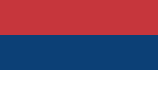
Civil flag of Serbia.
-
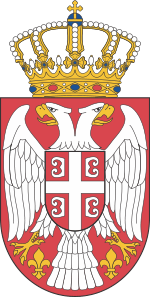
Coat of arms, including the Serbian eagle and Serbian cross.
Traditions and customs
- Folklore
- Traditional clothing varies due to diverse geography and climate of the territory inhabited by the Serbs. The traditional footwear, opanci, is worn throughout the Balkans.[68] The most common folk costume of Serbia is that of Šumadija, a region in central Serbia,[69] which includes the national hat, the Šajkača.[70][71] Older villagers still wear their traditional costumes.[69]
- The traditional dance is the circle dance, called kolo.
- Traditions
- slava is the family's annual ceremony and veneration of their patron saint, a social event in which the family is together at the house of the patriarch. The tradition is an important ethnic marker of Serb identity.[72] Serbs usually regard the Slava as their most significant and most solemn feast day.[73]
- Serbs have their own customs regarding Christmas, which includes the sacral tree, the badnjak, a young oak.
- On Orthodox Easter, Serbs have the tradition of Slavic Egg decorating.
-
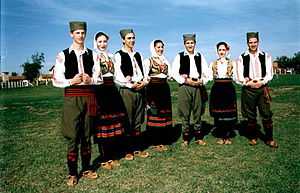
Serbian folk attire from Šumadija region.
-

Old Silent dance from Glamoč.
-

slava, a family feast in honour of its patron saint.
Cuisine

Serbian cuisine is largely heterogeneous, with heavy Oriental, Hungarian and Mediterranean influences.[74] Despite this, it has evolved and achieved its own culinary identity. Food is very important in Serbian social life, particularly during religious holidays such as Christmas, Easter and feast days, i.e., slava.[74]
Staples of the Serbian diet include bread, meat, fruits, vegetables, and dairy products. Traditionally, three meals are consumed per day. Breakfast generally consists of eggs, meat and bread. Lunch is considered the main meal, and is normally eaten in the afternoon. Traditionally, Turkish coffee is prepared after a meal, and is served in small cups.[74]
Bread is the basis of all Serbian meals, and it plays an important role in Serbian cuisine and can be found in religious rituals. A traditional Serbian welcome is to offer bread and salt to guests. Meat is widely consumed, as is fish. Serbian specialties include kajmak (a dairy product similar to clotted cream), proja (cornbread), kačamak (corn-flour porridge), and Gibanica (cheese and kajmak pie). Ćevapi are the national dish of Serbia. They are caseless sausages made of minced meat, which is always grilled and seasoned.[74]
Serbia is also the birthplace of rakia (rakija in Serbian), which is a very alcoholic drink primarily distilled in fruit. This Serbian drink is also found throughout the Balkans as it has grown popular in Croatia, Slovenia, Montenegro, Hungary, Romania and Turkey. The most famous brand of rakia is "Slivovitz" or plum rakia or plum brandy, which is also the national drink of Serbia. Other more frequent rakia's are from pears while highly sought after are made from quince.
Sport
Serbs are famous for their sporting achievements, and have produced many talented athletes.

Over the years country gave many internationally renowned football players such as Dragan Džajić (officially recognized as "the best Serbian footballer of all times" by Football Association of Serbia; 1968 European Footballer of the Year third place) and more recent likes of Nemanja Vidić (Premier League Player of the Season and member of FIFPro World XI, both awards for 2008–09 and 2010–11 seasons respectively), Dejan Stanković (Serbia's most capped player with 103 appearances for national team), and Branislav Ivanović. Serbia has developed a reputation as one of the world's biggest exporters of expat footballers.[75]
Total of 22 Serbian players played in the NBA in last two decades, including Predrag "Peja" Stojaković (three-time NBA All-Star) and Vlade Divac (2001 NBA All-Star and FIBA Hall of Famer). Serbian players that have not played in the NBA but nevertheless made a great impact on the game in Europe include four members of FIBA Hall of Fame from the 1960s and 1970s – Dragan Kićanović, Dražen Dalipagić, Radivoj Korać, and Zoran Slavnić – as well as recent stars of European basketball such as Dejan Bodiroga (2002 All-Europe Player of the Year) and currently active Miloš Teodosić (2009–2010 Euroleague MVP). Renowned "Serbian coaching school" produced many of the most successful European basketball coaches of all times, such as Željko Obradović (won record eight Euroleague titles with four different clubs), Božidar Maljković (four Euroleague titles with three different clubs), Dušan Ivković (two Euroleague titles), and Svetislav Pešić.
Novak Đoković, eight-time Grand Slam champion and 2011 and 2014 Laureus Sportsman of the Year, finished in 2011, 2012 and 2014 as No. 1 in the world and is currently No. 1 in the ATP Rankings.[76] Ana Ivanovic (champion of 2008 French Open) and Jelena Janković were both ranked No. 1 in the WTA Rankings.
Other noted Serbian athletes include: swimmers Milorad Čavić (2009 World champion on 50 meters butterfly and silver medalist on 100 meters butterfly as well as 2008 Olympic silver medalist on 100 meters butterfly in historic race with American swimmer Michael Phelps) and Nađa Higl (2009 World champion in 200 meters breaststroke – the first Serbian woman to become a world champion in swimming); track and field athletes Emir Bekrić (hurdler; bronze medalist at the 2013 World Championships) and Ivana Španović (long-jumper; bronze medalist at the 2013 World Championships); shooter Jasna Šekarić (1988 Olympic gold medalist) and taekwondoist Milica Mandić (2012 Olympic gold medalist).
See also
- List of medieval Slavic tribes
- List of Serb countries and regions
- List of Serbs
- Serb clans, former feudal organizations of Montenegro and Herzegovina
Annotations
References
- ↑ The Serbian Diaspora and Youth: Cross-Border Ties and Opportunities for Development, Theodore E. Baird, Roskilde University and Amanda Klekowski von Koppenfels, University of Kent at Brussels p. 5.
- ↑ Ethnic Groups of Europe: An Encyclopedia, Ethnic Groups of the World, Jeffrey E. Cole, ABC-CLIO, 2011, ISBN 1598843036, pp. 333–334.
- ↑ Toal & Dahlman 2011, p. 4.
- ↑ "The World Factbook". Cia.gov. Retrieved 2014-04-17.
- ↑ Croatian Bureau of Statistics 2011.
- ↑ "Census of Population, Households and Dwellings in Montenegro 2011" (PDF). July 12, 2011. Retrieved 13 July 2011.
- ↑ Demographics of the Republic of Macedonia
- ↑ http://www.stat.si/eng/novica_prikazi.aspx?id=4430. Missing or empty
|title=(help) - ↑ "Srbi u Austriji traže status nacionalne manjine". Blic. 2010-10-02.
"Srba u Austriji ima oko 300.000, po brojnosti su drugi odmah iza Austrijanaca i više ih je od Slovenaca, Mađara i Gradištanskih Hrvata zajedno, koji po državnom ugovoru iz 1955. godine imaju status nacionalne manjine u Austriji", navodi se u saopštenju.
- ↑ "Sverige vill öppna Serbienförhandlingar" (in Swedish). SvD. 2015-02-02.
Det bor cirka 120 000 serber i Sverige.
- ↑ "So, just how many Serbs live in Britain? Britić figures defy census figures of 2001.". Ebritic.com. June 3, 2011.
The Serbian Embassy made their own estimate ten years ago and arrived at a figure of 70,000.
- ↑ "Официальные статистические данные Статистические сведения в отношении иностранных граждан, находящихся на территории Российской Федерации Сведения в отношении иностранных граждан, находящихся на территории Российской Федерации, в половозрастном разрезе (по состоянию на 4 марта 2015 г.)". Federal Migration Service (Russia). 2015. Retrieved 2015-04-02.
- ↑ "1. НАЦИОНАЛЬНЫЙ СОСТАВ НАСЕЛЕНИЯ" (PDF). Russian Federal State Statistics Service. 2010. Retrieved 2015-04-02.
- ↑ "Tab11. Populaţia stabilă după etnie şi limba maternă, pe categorii de localităţi". Rezultate definitive_RPL_2011 (Institutul Naţional de Statistică). 2011. Retrieved 2014-04-17.
- ↑ 15.0 15.1 http://factfinder2.census.gov/faces/tableservices/jsf/pages/productview.xhtml?pid=ACS_12_1YR_B04003&prodType=table
- ↑ 16.0 16.1 "2011 National Household Survey: Data tables". 2.statcan.gc.ca. Retrieved 2014-04-17.
- ↑ "The People of Australia - Statistics from the 2011 Census" (PDF). Department of Immigration and Border Protection. 2014. p. 59. ISBN 978-1-920996-23-9.
Ancestry
- ↑ http://serbiosunidos.com/latino-america/inmigrantes-serbios-en-america-latina/. Missing or empty
|title=(help) - ↑ "Final Results of the 2011 Kosovo census". Esk.rks-gov.net. Retrieved 2014-05-22.
- ↑ "Number of Serbs in northern Kosovo disputed". Setimes.com. 2012-08-20. Retrieved 2014-05-22.
- ↑ http://www.monstat.org/userfiles/file/popis2011/saopstenje/saopstenje%281%29.pdf
- ↑ "Australian Bureau of Statistics (2011)". Abs.gov.au. 2012-08-16. Retrieved 2014-05-22.
- ↑ Powell 2005, pp. 267.
- ↑ Christopher Catherwood (1 January 2002). Why the Nations Rage: Killing in the Name of God. Rowman & Littlefield. pp. 135–. ISBN 978-0-7425-0090-7.
- ↑ (PDF) http://www.scielo.cl/pdf/ijmorphol/v31n1/art43.pdf. Missing or empty
|title=(help) - ↑ 26.0 26.1 Miller 2005, p. 533.
- ↑ 27.0 27.1 27.2 27.3 Cox 2002, p. 20.
- ↑ Cox 2002, p. 21.
- ↑ Cox 2002, p. 23.
- ↑ 30.0 30.1 30.2 Cox 2002, pp. 23–24.
- ↑ 31.0 31.1 Judah 2002, p. 5.
- ↑ Judah 2000, p. 27.
- ↑ 33.0 33.1 Judah 2002, p. 7–8.
- ↑ Ágoston & Masters 2009, pp. 518–519.
- ↑ Miller 2005, p. 542.
- ↑ Pavlowitch 2002, p. 94.
- ↑ Miller 2005, pp. 542–543.
- ↑ Miller 2005, p. 544.
- ↑ 39.0 39.1 Miller 2005, p. 545.
- ↑ Yugoslavian Front (WWII)#Casualties
- ↑ Miller 2005, pp. 546–553.
- ↑ Miller 2005, pp. 558–562.
- ↑ Gall 2000.
- ↑ Pavlowitch 2002, p. 225.
- ↑ "Biz - Vesti - Srbi za poslom idu i na kraj sveta". B92. Retrieved 2014-04-17.
- ↑ "Serbia seeks to fill the '90s brain-drainage gap". EMG.rs. 5 September 2008.
- ↑ "Survey S&M 1/2003". Yugoslav Survey.
- ↑ Cox 2002, pp. 11–12.
- ↑ 49.0 49.1 Cox 2002, p. 12.
- ↑ Judah 2000, p. 69.
- ↑ Cox 2002, p. 121.
- ↑ 52.0 52.1 52.2 Miller 2005, pp. –565–567.
- ↑ 53.0 53.1 Bédé & Edgerton 1980, p. 734.
- ↑ Sollars & Jennings 2008, p. 604.
- ↑ "Projekat Rastko: Istorija srpske kulture". Rastko.rs. Retrieved 24 May 2012.
- ↑ "Stevan Stojanović Mokranjac (1856—1914)". Riznicasrpska.net. 28 September 1914. Retrieved 24 May 2012.
- ↑ Cox 2002, p. 13.
- ↑ 58.0 58.1 UNICEF Serbia.
- ↑ Blic 30 May 2013.
- ↑ "The Official Milla Jovovich Website :: Biography". Retrieved 10 November 2008.
- ↑ Consulate General of the Republic of Serbia.
- ↑ Benjamin W. Fortson, IV (7 September 2011). Indo-European Language and Culture: An Introduction. John Wiley & Sons. p. 431. ISBN 978-1-4443-5968-8.
- ↑ Dejan Ivković (2013). "Pragmatics meets ideology: Digraphia and non-standard orthographic practices in Serbian online news forums". Journal of Language and Politics (John Benjamins Publishing Company) 12 (3). doi:10.1075/jlp.12.3.02ivk.
- ↑ Mojca Ramšak (2008). "Karadžić, Vuk Stefanović (1787-1864)". In Donald Haase. The Greenwood Encyclopedia of Folktales and Fairy Tales: G-P. Westport, Connecticut: Greenwood Publishing Group. p. 531. ISBN 9780313334436.
- ↑ Tanjug. "Srbija, zemlja Milice i Dragana : Društvo : POLITIKA". Politika.rs. Retrieved 2014-04-17.
- ↑ Cvetković 2012, p. 130.
- ↑ Christian Promitzer, Klaus-Jürgen Hermanik, and Eduard Staudinger. (Hidden) Minorities: Language and Ethnic Identity Between Central Europe and the Balkans. The Lit Verlag in 2009. Retrieved 5 February 2013.
- ↑ Mirjana Prošić-Dvornić (1989). Narodna nošnja Šumadije. Kulturno-Prosvjetni Sabor Hrvatske. p. 62.
- ↑ 69.0 69.1 Dragoljub Zamurović; Ilja Slani; Madge Phillips-Tomašević (2002). Serbia: life and customs. ULUPUDS. p. 194.
- ↑ Deliso, Christopher (2009). Culture and Customs of Serbia and Montenegro. Westport, Connecticut: Greenwood Publishing Group. p. 97. ISBN 978-0-313-34436-7.
- ↑ Resić, Sanimir; Plewa, Barbara Törnquist (2002). The Balkans in Focus: Cultural Boundaries in Europe. Lund, Sweden: Nordic Academic Press. p. 48. ISBN 978-91-89116-38-2.
- ↑ Ethnologia Balkanica. LIT Verlag Münster. pp. 70–. GGKEY:ES2RY3RRUDS.
- ↑ Celia Jaes Falicov (1991). Family Transitions: Continuity and Change Over the Life Cycle. New York City: Guilford Press. p. 219. ISBN 978-0-89862-484-7.
- ↑ 74.0 74.1 74.2 74.3 Albala 2011, pp. 328–330.
- ↑ Soccerlens – 27 January 2010 – Serbia's Endless List of Wonderkids
- ↑ "Current ATP Rankings (singles)". Association of Tennis Professionals.
- ↑ 77.0 77.1 (PDF) http://www.serbianunity.com/serbianunitycongress/pdf/world_of_serbs/Serbs_Around_the_World_by_Region.pdf. Missing or empty
|title=(help) - ↑ Theodore E. Baird, Roskilde University and Amanda Klekowski von Koppenfels. "The Serbian Diaspora and Youth: Cross-Border Ties and Opportunities for Development" (PDF). University of Kent at Brussels. p. 5.
- ↑ Jeffrey E. Cole (2011). Ethnic Groups of Europe: An Encyclopedia. ABC-CLIO. pp. 333–334. ISBN 1598843036.
Sources
Books
- Albala, Ken (2011). Food Cultures of the World Encyclopedia. Santa Barbara, California: ABC-CLIO. ISBN 978-0-313-37626-9.
- Ágoston, Gábor; Masters, Bruce Alan (2009). Encyclopedia of the Ottoman Empire. New York, New York: Infobase Publishing. ISBN 978-1-4381-1025-7.
- Bédé, Jean Albert; Edgerton, William Benbow (1980). The Columbia Dictionary of Modern European Literature. New York, NY: Columbia University Press. ISBN 978-0-231-03717-4.
- Cox, John K. (2002). The History of Serbia. Westport, Connecticut: Greenwood Press. ISBN 978-0-313-31290-8.
- Cvetković, Vladimir (2012). Casiday, Augustine, ed. The Orthodox Christian World. London: Routledge. ISBN 978-1-136-31484-1.
- Judah, Tim (2000). The Serbs: History, Myth and the Destruction of Yugoslavia. New Haven: Yale University Press. ISBN 978-0-300-08507-5.
- Judah, Tim (2002). Kosovo: War and Revenge. New Haven: Yale University Press. ISBN 978-0-300-09725-2.
- Judah, Tim (2008). Kosovo: What Everyone Needs to Know. Oxford: Oxford University Press. ISBN 978-0-19-974103-8.
- Martinez, Jose de Luna; Endo, Isaku; Barberis, Corrado (2006). The Germany-Serbia Remittance Corridor: Challenges of Establishing a Formal Money Transfer System. Washington, D.C.: World Bank Publications. ISBN 978-0-8213-6659-2.
- Midlarsky, Manus I. (2005). The Killing Trap: Genocide in the Twentieth Century. Cambridge: Cambridge University Press. ISBN 978-1-139-44539-9.
- Miller, Nicholas (2005). Frucht, Richard C., ed. Eastern Europe: An Introduction to the People, Lands, and Culture, Volume 1. Santa Barbara, California: ABC-CLIO. ISBN 978-1-57607-800-6.
- Pavlowitch, Stevan K. (2002). Serbia: The History of an Idea. New York, NY: New York University Press. ISBN 978-0-8147-6708-5.
- Sollars, Michael David; Jennings, Arbolina Llamas (2008). The Facts on File Companion to the World Novel: 1900 to the Present. New York, NY: Infobase Publishing. ISBN 978-1-4381-0836-0.
- Toal, Gerard; Dahlman, Carl T. (2011). Bosnia Remade: Ethnic Cleansing and Its Reversal. Oxford, England: Oxford University Press. ISBN 978-0-19-973036-0.
Web
- Palić, Svetlana (17 July 2011). "Četiri miliona Srba našlo uhlebljenje u inostranstvu". Blic.
- "Inicijativa da Karl Malden u Beogradu dobije spomenik i ulicu". Blic. 30 May 2013.
- "Restaurisana kopija filma Karađorđe". B92. 26 November 2011.
- Crippe, Chadd (4 April 2013). "Davis Cup: Djokovic a true national hero in Serbia". The Idaho Statesman.
- "Population by Ethnicity, censuses 1971–2011". Croatian Bureau of Statistics.
- Great Serbian scientists. Consulate General of the Republic of Serbia.
- Gall, Carlotta (7 May 2000). "New Support to Help Serbs Return to Homes in Kosovo". The New York Times.
- "Results of census in Serbia". International Radio Serbia. 1 December 2012.
- "Emir Kusturica". UNICEF Serbia.
- "Total ancestry categories tallied for people with one or more ancestry categories reported 2010 American Community Survey 1-Year Estimates". United States Census Bureau.
- "Serben-Demo eskaliert in Wien". 20 Minuten (in German). 24 February 2008.
External links
| Wikimedia Commons has media related to Serbs. |
- Project Rastko – Serbian cultural and historical research society
- Articles about the Serbs by Westerners
| ||||||||||||||||||||||||||||||||
| |||||||||||||
| ||||||||||||||||
| ||||||||||||||||||||||||




